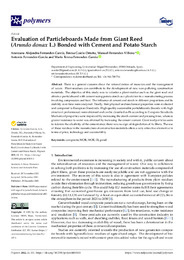Por favor, use este identificador para citar o enlazar este ítem:
https://hdl.handle.net/11000/34604Registro completo de metadatos
| Campo DC | Valor | Lengua/Idioma |
|---|---|---|
| dc.contributor.author | Ferrández-Villena, Manuel | - |
| dc.contributor.author | Garcia-Ortuño, Teresa | - |
| dc.contributor.author | FERRÁNDEZ, MARÍA TERESA | - |
| dc.contributor.author | Ferrández García, Antonio | - |
| dc.contributor.author | Ferrandez-García, Aranzazu Alejandra | - |
| dc.contributor.other | Departamentos de la UMH::Ingeniería | es_ES |
| dc.date.accessioned | 2025-01-16T17:56:08Z | - |
| dc.date.available | 2025-01-16T17:56:08Z | - |
| dc.date.created | 2022 | - |
| dc.identifier.citation | Polymers | es_ES |
| dc.identifier.issn | 2073-4360 | - |
| dc.identifier.uri | https://hdl.handle.net/11000/34604 | - |
| dc.description.abstract | There is a general concern about the rationalization of resources and the management of waste. Plant residues can contribute to the development of new non-polluting construction materials. The objective of this study was to valorize a plant residue such as the giant reed and obtain a particleboard with cement using potato starch as a plasticizer in a manufacturing process involving compression and heat. The influence of cement and starch in different proportions and its stability over time were analyzed. Finally, their physical and mechanical properties were evaluated and compared to European Standards. High-quality sustainable particleboards (boards with high structural performance) were obtained and can be classified as P6 according to European Standards. Mechanical properties were improved by increasing the starch content and pressing time, whereas greater resistance to water was obtained by increasing the cement content. Giant reed particles seem to tolerate the alkalinity of the cement since there was no sign of degradation of its fibers. The use of these residues in the manufacture of construction materials offers a very attractive alternative in terms of price, technology and sustainability. | es_ES |
| dc.format | application/pdf | es_ES |
| dc.format.extent | 5 | es_ES |
| dc.language.iso | spa | es_ES |
| dc.publisher | MDPI | es_ES |
| dc.relation.ispartofseries | 14 | es_ES |
| dc.relation.ispartofseries | 1 | es_ES |
| dc.rights | info:eu-repo/semantics/openAccess | es_ES |
| dc.rights | Attribution-NonCommercial-NoDerivatives 4.0 Internacional | * |
| dc.rights.uri | http://creativecommons.org/licenses/by-nc-nd/4.0/ | * |
| dc.subject | composite | es_ES |
| dc.subject | MOR | es_ES |
| dc.subject | MOE | es_ES |
| dc.subject | IB | es_ES |
| dc.subject | panel | es_ES |
| dc.subject.other | CDU::6 - Ciencias aplicadas::62 - Ingeniería. Tecnología | es_ES |
| dc.title | Evaluation of Particleboards Made from Giant Reed (Arundo donax L.) Bonded with Cement and Potato Starch | es_ES |
| dc.type | info:eu-repo/semantics/article | es_ES |
| dc.relation.publisherversion | https://doi.org/10.3390/polym14010111 | es_ES |

Ver/Abrir:
2021.- Polymers. Evaluation of Particleboards.pdf
203,36 kB
Adobe PDF
Compartir:
 La licencia se describe como: Atribución-NonComercial-NoDerivada 4.0 Internacional.
La licencia se describe como: Atribución-NonComercial-NoDerivada 4.0 Internacional.
.png)